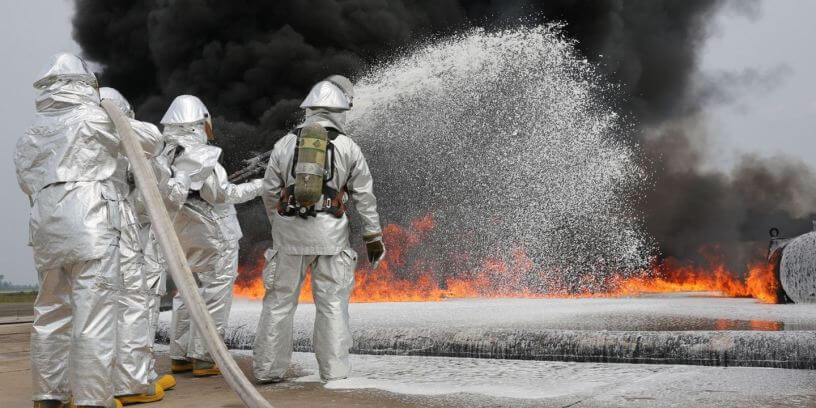DNR Releases PFAS Contamination Data
PFAS chemicals have been linked to a multitude of health problems

Marines fighting fires with foam, a product that uses PFAS . Photo by Lance Cpl. Shawn Valosin/U.S. Marine Corps.
High levels of PFAS chemicals that have caused recent alarm in several parts of the state have been detected in two waterways, data posted online Monday by the Wisconsin Department of Natural Resources shows. Other areas of the state have shown much smaller levels of the substances,
Meanwhile, test results from yet another river where PFAS contamination has triggered close scrutiny and public concern have not yet been completed.
The findings come from a database posted on the web by the DNR as part of a new effort to promote greater awareness of the chemical category in the environment.
“It’s not to cause alarm,” DNR spokeswoman Sarah Hoye said of the database. “It’s not to have people not drink their water. It’s awareness at this point.”
PFAS is the abbreviation for perfluoroalkyl and polyfluoroalkyl substances, a class of manufactured chemicals that have been used in industry and a wide range of consumer products for more than 60 years, particularly in fire suppression foam chemicals.
Ingesting food or water contaminated with PFAS has been linked to human reproductive and development changes and effects on the liver, kidneys, and immune system as well as thyroid problems, lower infant birth-weights, tumors, and cancer.
To date, however, the federal EPA hasn’t set official standards for PFAS concentrations to be considered a threat to human health. As a benchmark, said Hoye, the state is using 20 parts per trillion (20 ppt). Above that level, “the higher it gets, the worse it is.”
The first round of sampling, which is still underway, is focused on establishing baseline levels of contamination in waterways where the chemicals are found, said Hoye.
The concentration of contamination in the sample data is displayed in nanograms/liter, equivalent to parts per trillion.
Starkweather Creek in Madison, which rises near Truax Field, the site of regular firefighting exercises at which fire suppression foams were used, showed particularly high levels of PFAS chemicals. One category, PFOS for short, ranged from concentrations of 79 to 270 ppt in the are most subject to exposure. The other category, PFOA, ranged from 23 to 43 ppt.
Along the Wisconsin River between Rhinelander and Nekoosa, concentrations ranged from 6.5 to 23 ppt for PFOA and 3 to 3.1 ppt for PFOS.
In Monroe County, two waterways near Fort McCoy, another fire-suppression training site, generally showed much lower concentrations: for PFOA, a range of 0.11 to 4 ppt; for PFOS, 0.11 to 4 ppt. For PFOS, concentrations included undetectable and 0.59, but a sharply higher 29 at one location along Silver Creek.
Along the Mississippi River, in an area spanning Pierce, Pepin, Buffalo and Vernon counties, concentrations ranged from 2.3 to 5.2 ppt for PFOA and 1.7 to 3.1 ppt for PFOS. And along the Menomonee River in a short stretch of Marinette, concentrations ran from 0.32 to 0.6 ppt for PFOA and from undetectable to 0.31 ppt for PFOS.
Andi Rich, a vocal critic of the DNR’s handling of the Marinette-Peshtigo contamination, called the release of the data on Monday “a step in the right direction” but expressed continued frustration at what she felt were insufficiently rapid efforts by the agency to address the broader issue. She questioned the accuracy of some of the reported data given how concentrations varied along some waterways.
Darsi Foss, administrator for the DNR’s environmental management division, told Wisconsin Examiner that the agency was still learning how the chemical category behaves and that only with further tests over time would it be possible to understand possible explanations for the variations.
Following the DNR announcement of the posting of its database, Sen. Tammy Baldwin (D-Wis.), who met in Marinette last month with government and business officials about the PFAS contamination there, released a statement renewing her call for the federal Centers for Disease Control and Prevention as well as the EPA “to step up and invest in research on how PFAS chemicals harm human health and establish meaningful standards to help protect Wisconsinites from PFAS exposure.”
Reprinted with permission of Wisconsin Examiner.
More about the PFAS Problem
- Environmental Groups, Community Advocates Push for PFAS Deal - Henry Redman - Jul 14th, 2025
- Environmental Advocates Hail Wisconsin Supreme Court Decision in Evers v Marklein - Midwest Environmental Advocates - Jul 8th, 2025
- Wisconsin Supreme Court Backs State Regulators of PFAS Pollution - Danielle Kaeding and Rich Kremer - Jun 24th, 2025
- Gov. Evers Releases Statement on Wisconsin Supreme Court Decision in WMC Inc v. DNR - Gov. Tony Evers - Jun 24th, 2025
- Rep. Shelia Stubbs Elected Great Lakes-St. Lawrence Legislative Caucus Vice Chair of the Task Force on Emerging Contaminants - State Rep. Shelia Stubbs - Jun 16th, 2025
- Legislature’s Budget Committee Unanimously Boosts Clean Water Funding By $732 Million - Danielle Kaeding - Jun 6th, 2025
- Trump Administration moves to weaken standards for toxic ‘forever chemicals’ in drinking water - Clean Wisconsin - May 14th, 2025
- Wisconsin Officials Unhappy With EPA Plan To Weaken PFAS Standards - Danielle Kaeding - May 14th, 2025
- Wisconsin Could Lose $55 Million Under Proposed EPA Budget Cuts - Danielle Kaeding - May 7th, 2025
- French Island Makes Progress on PFAS Pollution - Richelle Wilson and Trevor Hook - Mar 24th, 2025
Read more about PFAS Problem here




















